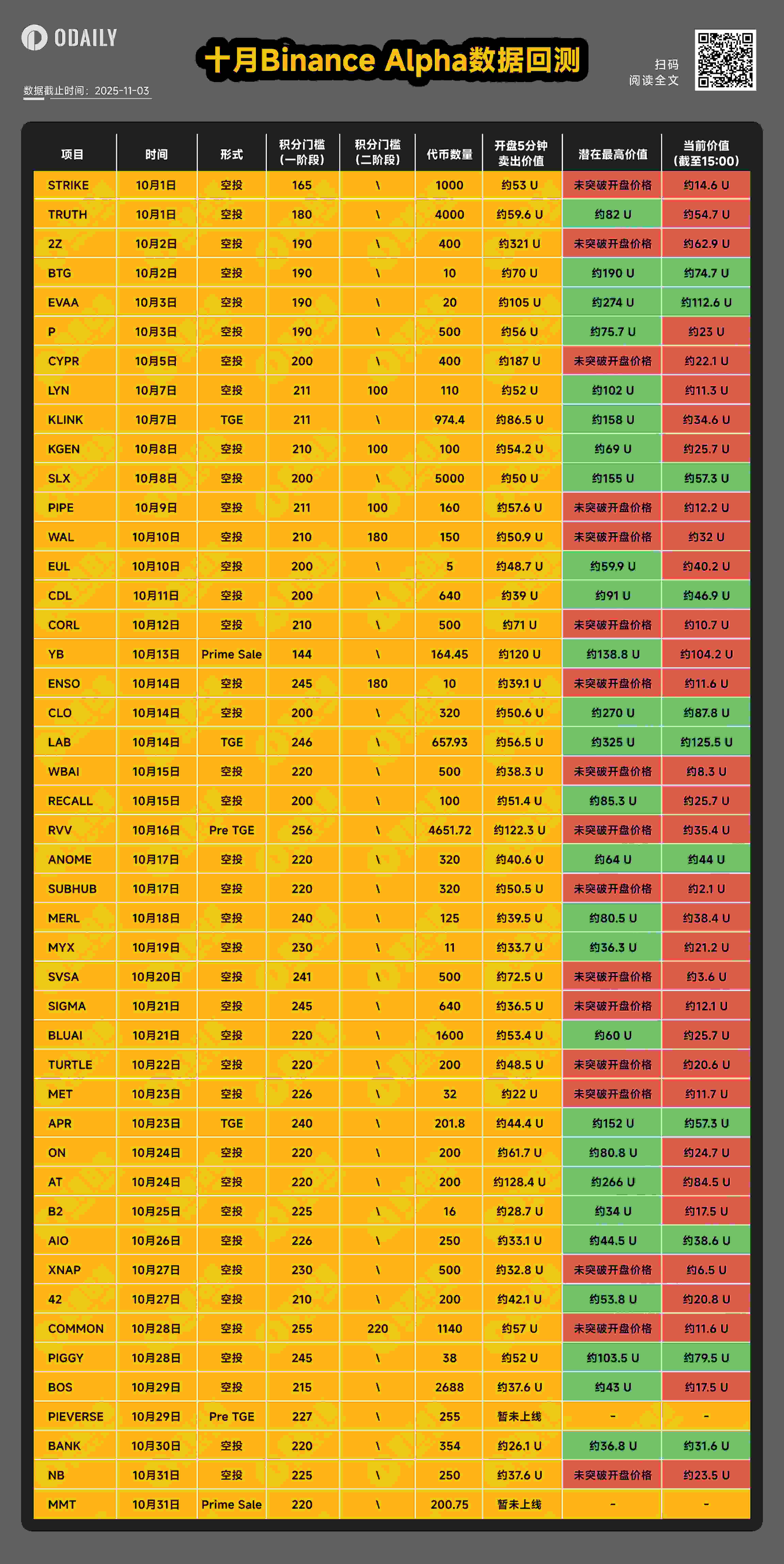Original | Odaily Planet Daily (@OdailyChina)
 The recently concluded October may not have been a good month for all Binance Alpha users, especially for those new users who were attracted by the wealth effect in September. If they continued to use the previously aggressive scoring strategies or had poor operational discipline, they likely ended up with a net loss.
The recently concluded October may not have been a good month for all Binance Alpha users, especially for those new users who were attracted by the wealth effect in September. If they continued to use the previously aggressive scoring strategies or had poor operational discipline, they likely ended up with a net loss.
There are two main reasons for this situation. On one hand, it can be simply summarized as "too many monks." With more and more new users (not entirely "users") entering the market, the points threshold keeps rising, and competition during the claiming phase is intensifying. Many users can only watch helplessly as their shares are claimed amidst endless errors and verifications. On the other hand, there is "too little meat." Due to the overall market downturn, the single-coin yield has shown a significant decline.
In the following text, we review all the airdrops, TGEs, Pre-TGEs, and Prime Sale activities of Binance Alpha in October and attempt to identify patterns, hoping to help you optimize your scoring and trading strategies in this new normal of "too many monks and too little meat."

Phenomenon: Rising Points, Declining Yields, "Long-term Holding" Not as Good as "Quick Selling"
Based on the data performance in the above chart, the following information can be summarized:
Throughout October, Binance Alpha conducted a total of 46 activities, including 40 airdrops, 2 TGEs, 2 Pre-TGEs, and 2 new activities in the Prime Sale.
Excluding the tokens that have not yet launched, PIEVERSE (Pre-TGE) and MMT (Prime Sale), and calculating based on the price sold within 5 minutes after opening (for "old coins" like MERL that are already online, based on the claiming time), the average yield of the 46 activities is approximately $64 (not accounting for the cost wear of TGE-type activities, the same applies below). Overall, the yield differences among different types of activities are not significant—although Pre-TGE and Prime Sale show higher single-event yields, their limited sample size makes them less meaningful for reference.
During October, the points threshold for Binance Alpha activities kept rising—the average points threshold for the 14 activities in the first half of the month was 197 points; in the middle of the month, the average points threshold rose to 219.4 points; and in the last ten days, the average points threshold further increased to 227.2 points. Additionally, the number of phase-based airdrop activities, which are more friendly to retail investors, has decreased, with 4 in the first half of the month, and only 1 in both the middle and last ten days.
In terms of yield, based on the price sold within 5 minutes after opening, the average yield for the 14 activities in the first half of the month was $89.4, with 3 activities (2Z, EVAA, CYPR) exceeding $100; 2Z even became the top "big winner" of the month. In the middle of the month, the average yield for the 14 activities was $58.9, with only 2 activities (YB, RVV) exceeding $100; in the last ten days, the average yield for the 18 activities was $46.4, with only 1 activity (AT) exceeding $100.
As for whether to sell or hold after receiving the tokens, out of the 44 tokens that have been launched, 17 reached their peak immediately after opening, while the remaining 27 tokens had better selling points at some point; if we consider the time up to the table's cutoff (November 3, 15:00), 33 tokens had prices lower than their opening, with a few tokens like SUBHUB (around $2.1) and SIGMA (around $3.6) dropping to single digits—although "selling immediately upon receipt" may never capture the maximum value, it is at least a relatively good choice and can effectively avoid the mental exhaustion of monitoring prices later.
Conclusion: There is Still Room for Profit, but Strategies Need Optimization
From the above points, we can see more clearly the current trend of "too many monks and too little meat" in Binance Alpha. For retail investors, besides continuing to wait for Binance to crack down on studios, they must also subjectively optimize their strategies to adapt to the environment.
Considering the average points threshold of 227.2 in the last ten days and the average yield of $46.4, although Binance Alpha's yields have shrunk, there is still some room for profit—even by using the most stable KOGE to score the basic "3 + 14" package, there is a chance to receive 2 to 3 rewards within a cycle, and the wear can be controlled around $50.
The current Binance Alpha may never replicate the wealth effect of September, but if strict discipline and wear control can be maintained, there is still an opportunity to obtain some relatively stable "pork rice." As for various strategies to reduce wear and advance, it is a matter of personal opinion.
免责声明:本文章仅代表作者个人观点,不代表本平台的立场和观点。本文章仅供信息分享,不构成对任何人的任何投资建议。用户与作者之间的任何争议,与本平台无关。如网页中刊载的文章或图片涉及侵权,请提供相关的权利证明和身份证明发送邮件到support@aicoin.com,本平台相关工作人员将会进行核查。



